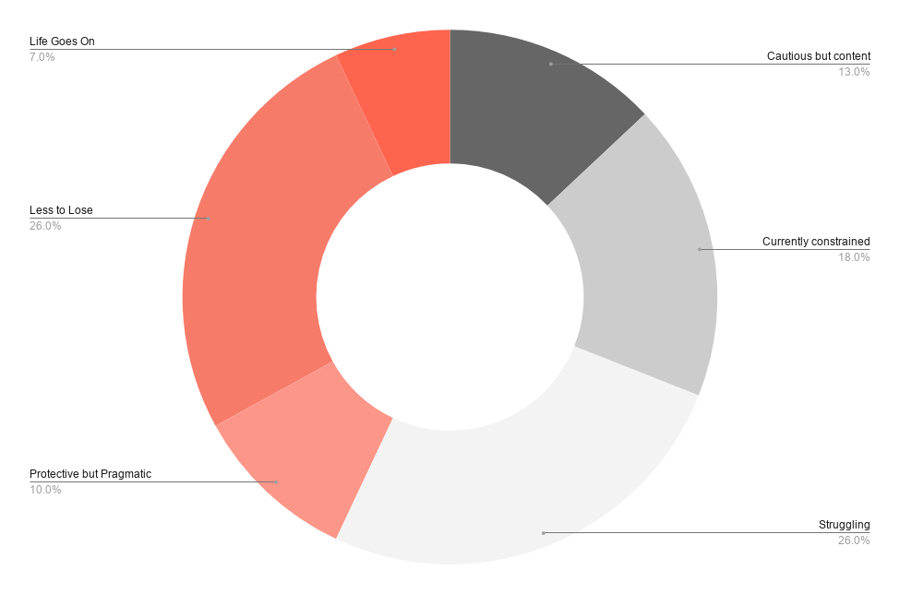The New COVID Consumer Segments

Tracking the UK’s sentiment towards Coronavirus is no easy task. To keep up with the constantly shifting guidelines, insights need to be regularly monitored and adapted to ensure they don’t become out of date.
In mid-August, 39% of the population were essentially ‘over COVID’. The excellent sentiment tracker from BVA-BDRC, especially the ‘Life Goes On’ category, captured a strong snapshot of the public’s perception of the pandemic. It’s been a few months since then, and as we have had increasingly confusing news about restrictions, it would be safe to assume this proportion has increased – but what was missing, was a nuance of why exactly people were fed-up and what that means for their behaviour.
I must not have been the only person feeling the same, as the diligent researchers at BVA BDRC announced their newly evolved COVID Consumer Segments during the virtual launch event of their new service Clearsight. In this article, I will give a quick rundown of the new segments and what they mean for tourism marketers, but I would recommend reading the full report yourself.

COVID Consumer Segment Split October 2020 Source: BVA-BDRC
How the COVID consumer segments have changed
This new analysis of the UK’s sentiment towards COVID-19 took into account more than just the risks involved. Instead, it was segmented through the attitudes towards risk, finance and spending and how much someone’s leisure activities.
This meant that the previously more all-encompassing categories such as ‘Life Goes On’ and ‘COVID concerned’ could be split effectively to draw different conclusions about how their attitudes fed into behaviour. Broadly speaking, the new six categories could be placed on an axis, going from COVID Cautious to COVID confident.
Covid Cautious (57%)
- Cautious but content – These are people who have been affected least by the pandemic. They tend to be slightly older and more financially secure, so although they feel slightly restricted, they are pretty happy with the way things are going.
- Currently constrained – Demographic wise, this group is pretty similar to the ‘cautious but content’ category, but the difference is they are desperately missing their regular activities and yearn for them back. They love travelling, but due to safety concerns aren’t going anywhere yet, although are likely to be saving up for when they can.
- Struggling – These people have been hit hard and directly by the effects of COVID-19. For some people, this is due to health reasons but for many, it is due to financial pressures and as a result have no available funds for luxuries.
Covid confident (43%)
- Protective but Pragmatic – These are people who are engaging with leisure activities again, but are still being very sensible about it. They are concerned about safety, and so won’t take unnecessary risks, but are more likely to take part in a government-sanctioned scheme such as ‘eat out to help out’.
- Less to lose – This is a group mostly filled with spontaneous young optimists, and are probably the people you saw on a bar crawl a few weeks ago. They are those whose leisure time has been affected the most due to the pandemic and are hoping that the worst is behind us. Although they may have limited funds, they want to spend that money on immediate experiences, rather than be stuck in isolation.
- Life goes on – These are your ‘die-hard’ travellers – if the opportunity for an experience they want is there, they are likely to take it. Similar to the ‘less to lose’ category, they want to get back to the way things were, but they are more likely to disagree with the restrictions and instead want the UK economy prioritised.
Be mindful of people’s budgets
As you can see from the graph above, over a quarter of the population have been profoundly affected by the pandemic and with potential stricter lockdowns and the furlough scheme coming to an end, this number is likely to become higher.
Although as marketers, it is our job to target those who will purchase your product, it is important to be mindful of those that may not be able to afford to come to you right away. Those that are ‘struggling’ may not have the funds, but some may be saving for an experience on the run-up to Christmas, especially if they have families.
By creating scaled experience packages, you will be able to appeal to those on a budget whilst also making your other packages feel more premium. As things are rapidly changing, people will be reluctant to purchase tickets if they don’t feel like they will receive what they have paid for, so try and be as flexible as you can. Though it may create a slight loss in the short-term, a good refund experience is one of the key drivers for long-term loyalty with a brand.
Attract the dreamers
During lockdown there has been a direct correlation between the amount of time people spent at home, and how much digital content they consumed. Even as the world slightly opened up again, for people who are ‘currently constrained’ this level of digital interaction has remained very high, and are more influenced by advertising they feel is relevant to their needs.
They may not feel ready to travel now, but they have been saving up for the right opportunity and for many they still haven’t made up their mind on what exactly that will be. This is exactly who you want to be targeting with longer-form content that will inspire them and give them something to fixate on over the coming months.
Showcase what they have been missing, alongside recent reviews to assure them they will be able to have the experience they have been craving, so when travel opens up fully you will be the first thing they spend their pent-up money on.
The power of social advertising
Though overall, a majority of people are COVID cautious, while tourism businesses are still running at reduced capacities there is still the potential to fill out all your bookings by targeting those that have ‘less to lose’ and those that feel ‘life goes on’.
The key to attracting both audiences is by talking about the experience you offer, and how they can enjoy it immediately. They don’t want to hear about safety measures and instead want to know they can enjoy the same activity they once did, or at least as close to it as possible. They want to be served content that is aspirational but attainable in the place they expect it the most – social media.
Despite the ‘life goes on’ segment who claim they aren’t swayed by adverts or any kind, both of these groups stated that social advertising is the most likely form of advertising they would act on. Therefore, it is integral to keep your social feeds active and form a digital advertising strategy that will encourage these audiences to visit you.
At Digital Visitor, our mission is to inspire people to do the things worth doing – which means visiting you. For any further information on anything I’ve mentioned or advice on how to implement them into your marketing activity, please drop me a message.
Jamie is Digital Visitor's Marketing Manager and oversees our messaging and content. If you are interested in knowing more about anything covered in this blog, or would like to see more on a certain topic please drop them an email.










